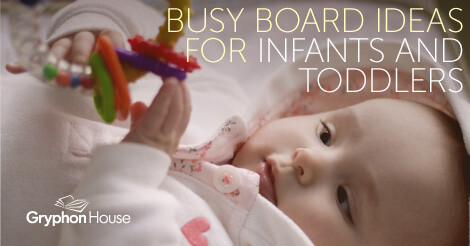DIY Busy Board Ideas for Infants and Toddlers
December 28th, 2016 | 3 min. read

Young children are always looking to keep busy, so what better way than with a busy board? Busy boards for babies are bulletin boards covered with fun objects infants and toddlers can play with to develop sensory processing and fine motor skills.
Young children are always looking to keep busy, so what better way than with a busy board? Busy boards for babies are bulletin boards covered with fun objects infants and toddlers can play with to develop sensory processing and fine motor skills. By setting out objects with an array of textures and movements, you encourage your baby to explore and discover new sensations. They’re easy to make with objects around the house, which is why toddler busy boards are so popular right now!
All you need is a board and any safe item you think will contribute to your baby’s sensory needs! What textures and objects are most useful to infants and toddlers? Karen Miller’s Simple Steps: Developmental Activities for Infants, Toddlers, and Two-Year-Olds, describes numerous sensory objects that contribute to young children’s cognitive development. Here are a few things you can add to your own DIY busy board!
Satin Streamers
Satin streamers are brightly colored and always in motion, which mean they’re bound to catch your baby’s eye. The smoothness of the fabric will appeal to young children’s sensory curiosity while the dangling ribbons will encourage them to reach out and try to grab, encouraging practice of fine motor skills.
To add them to your board, tie several satin ribbons to a hoop. Make sure they’re not long enough to wrap around the child’s neck! Pin or tie the hoop to the board and watch as your child reaches for the ribbons. If you want, help him discover the ribbons by dragging them across his palm. Look and see if he is able to catch the ribbons in his fist and how long the ribbons keep his attention.
Texture Patches
Texture patches are simple swaths of fabric that have interesting textures for a child to explore. These could be pieces of fabric that came from clothing or special fabric containing crinkling material, squeakers, or pockets. Having multiple pieces on the board will doubly appeal to children because they will be able to compare the various materials; all the fabric is soft, but some make noise, some have things to grab, and some are slick.
Attach the fabric to the board with tape or staples (making sure there are no pointy ends for the child to get hurt on). Encourage your child to feel all the fabrics. If she seems shy or apprehensive, gently move her hand to the fabric. Watch to see how she interacts with it. Is there a particular fabric she keeps going back to? Does she stroke it or hit it?
Noisy Paper
This could include cellophane, tissue paper, or any other type of paper that crunches when touched. The sound will immediately draw the attention of your baby. The paper is very moldable, and your child will be able to crumple it or even rip it if he’s enthusiastic enough! This will not only appeal to his sense of touch and sight, but sound as well, adding a new layer of sensory exploration.
Unlike with the fabric squares, the paper should only be fastened to the board on one or two sides so that the child can crumple it up and rip it. To reveal the sound element, go up to the paper and tap or squeeze it to show your child the sound. Watch his reaction. Does he seem to like the noise or not? Does he repeatedly crumple the paper and then release it, or does he grasp it for a long time? Note that the sound may not be pleasant for all babies, so if yours cringes or starts to cry at the sound, remove the paper from the board.
Ropes and Rattles
Add another noise and motion element with rattles! The sound will most likely be familiar, but now your child will be able to make them move by having them swing on the board. Using multiple different-shaped rattles will help motor skills and sensory development because the child will explore the feel of the new shape and learn how to grasp each one.
Attach the rattles to the board by tying yarn or ribbon around them and attaching the other end to the board. As with the satin ribbons, make sure the ropes are not long enough to table around your baby’s neck. This way, she can swing the rattles like a pendulum and observe the motion and sound. Look and see how her eyes follow the motion and how she manages to pick up the different kinds of rattles. Does she test different grips as she plays?
Topics: